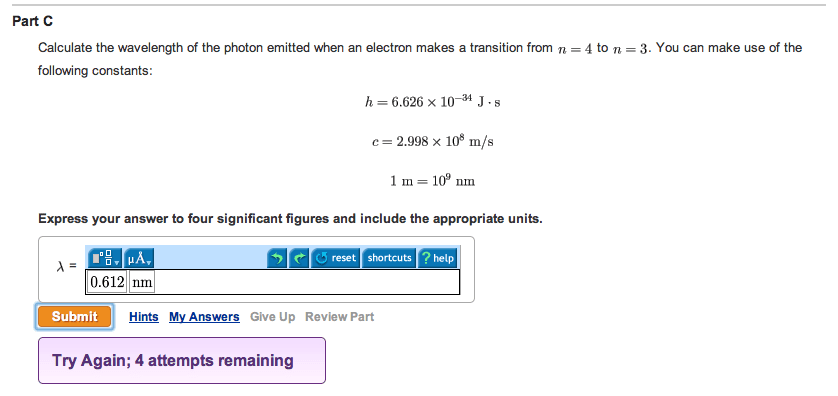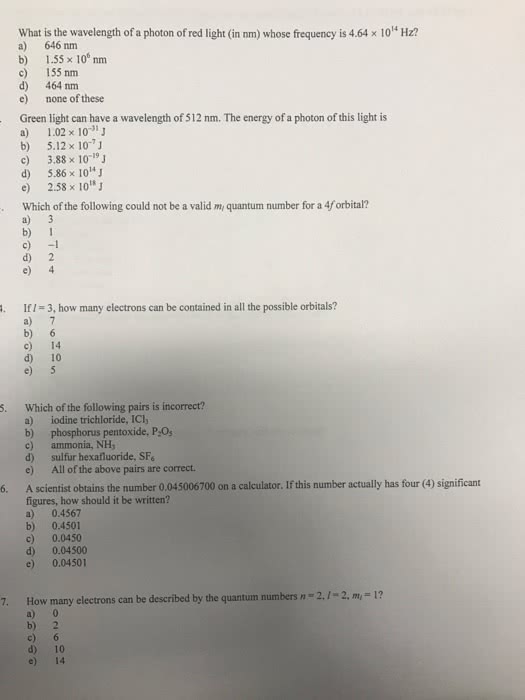jitbahadurthapa710
jitbahadurthapa710Indian Institute of Technology - IIT Kharagpur
0 Followers
0 Following
0 Helped
1 Oct 2023
Answer: Step-by-step explanation:thank you
1 Oct 2023
Answer: Step-by-step explanation: KEmax = hf - W where h is Planck's constant,...
1 Oct 2023
Answer: Step-by-step explanation: KEmax = hf - W where h is Planck's constant,...
1 Oct 2023
Answer: Step-by-step explanation:E=hc/λ+w λ=6.626x10^-34x 3x10^8/5.2x10^-19+2....
1 Oct 2023
Answer: Step-by-step explanation:a. f=c/λ λ=3x10^8/4.96x10^15 λ=604nm c. E= hc...
1 Oct 2023
Answer: Step-by-step explanation: KEmax = hf - W where h is Planck's constant,...
1 Oct 2023
Answer: Step-by-step explanation: E=hf =6.626x10^-34x5.03x10^14 E=33.32x10^-20...
1 Oct 2023
Answer: Step-by-step explanation:E=hf =6.626x10^-34x2.65x10^14 E=1.755x10^-19 ...
1 Oct 2023
Answer: Step-by-step explanation: You can find the work function of the metal ...
1 Oct 2023
Answer: Step-by-step explanation: You can find the work function of the metal ...
1 Oct 2023
Answer: Step-by-step explanation: You can find the work function of the metal ...
1 Oct 2023
Answer: Step-by-step explanation: The energy of a photon can be got from Planc...
1 Oct 2023
Answer: Step-by-step explanation: You can find the work function of the metal ...
1 Oct 2023
Answer: Step-by-step explanation: You can find the work function of the metal ...
1 Oct 2023
Answer: Step-by-step explanation: Each photon can free at least 1 electron, th...
1 Oct 2023
Answer: Step-by-step explanation:E=hf 3.68*10^-19 J=6.626x10^-34xf f=5.553x10^...
1 Oct 2023
Answer: Step-by-step explanation: The energy of a photon can be got from Planc...
1 Oct 2023
Answer: Step-by-step explanation: p shell n=2, l= 2n-1=1, ml=-1,0,1 d shell n=...
1 Oct 2023
Answer: Step-by-step explanation:2p subshell n-2 ,l= 2n-1 = 1, ml= -1,0,1
1 Oct 2023
Answer: Step-by-step explanation:n=4, l=n-1 =3, ml=0,1,2,3 -2,-1,0,1,2 -1,1 -1...
1 Oct 2023
Answer: Step-by-step explanation: n=3 to n=5 1/λ=R[1/n1^2−1/n2^2] 1/λ=10...
1 Oct 2023
Answer: Step-by-step explanation: n=3 to n=4 1/λ=R[1/n1^2−1/n2^2] 1/λ=10...
1 Oct 2023
Answer: Step-by-step explanation: n=3 to n=4 1/λ=R[1/n1^2−1/n2^2] 1/λ=10...
1 Oct 2023
Answer: Step-by-step explanation: n=3 to n=7 1/λ=R[1/n1^2−1/n2^2] 1/λ=10...
1 Oct 2023
Answer: Step-by-step explanation: Each photon can free at least 1 electron, th...
1 Oct 2023
Answer: Step-by-step explanation: a. E=hf h= 6.626x10^-34 Js , c= 3.00x10^8 m/...
1 Oct 2023
Answer: Step-by-step explanation: The energy of a photon can be obtained from ...
1 Oct 2023
Answer: Step-by-step explanation: a. E=hf h= 6.626x10^-34 Js , c= 3.00x10^8 m/...
1 Oct 2023
Answer: Step-by-step explanation: c. The energy of a photon can be got from Pl...
1 Oct 2023
Answer: Step-by-step explanation:a. E=hf=, h= 6.626x10^-34 Js , c= 3.00x10^8 m...
30 Sep 2023
Answer: Step-by-step explanation:a) E=hf=, h= 6.626x10^-34 Js , c= 3.00x10^8 m...
30 Sep 2023
Answer: Step-by-step explanation: n=3 to n=7 1/λ=R[1/n1^2−1/n2^2] 1/λ=10...
30 Sep 2023
Answer: Step-by-step explanation: n=3 to n=7 1/λ=R[1/n1^2−1/n2^2] 1/λ=10...
30 Sep 2023
Answer: Step-by-step explanation: n=3 to n=7 1/λ=R[1/n1^2−1/n2^2] 1/λ=10...
30 Sep 2023
Answer: Step-by-step explanation: n=4 to n=3 1/λ=R[1/n1^2−1/n2^2] 1/λ=10...
30 Sep 2023
Answer: Step-by-step explanation:E=hf=hc/λ,
30 Sep 2023
Answer: Step-by-step explanation: E=hf=hc/λ, h= 6.626x10^-34 Js , c= 3.00x10^8...
30 Sep 2023
Answer: Step-by-step explanation: E=hf=hc/λ, h= 6.626x10^-34 Js , c= 3.00x10^8...
30 Sep 2023
Answer: Step-by-step explanation: E=hf=hc/λ, h= 6.626x10^-34 Js , c= 3.00x10^8...
30 Sep 2023
Answer: Step-by-step explanation:1.f=c/λ, 4.64x10^14=3x10^8/λ, λ=646nm (a) 2. ...








